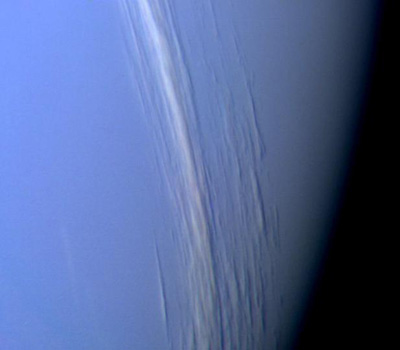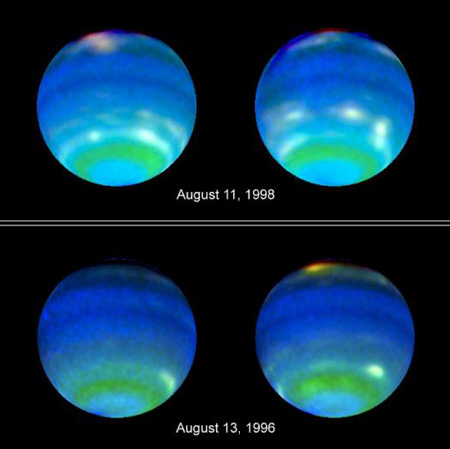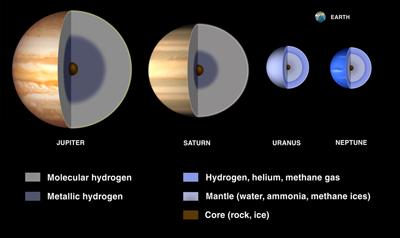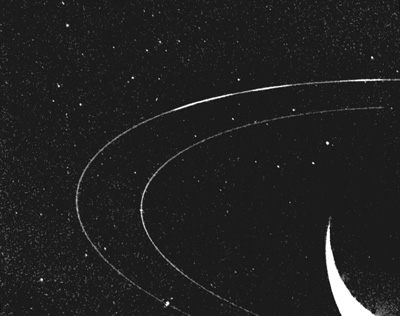Neptune is my favorite planet - I have no idea why.
Perhaps its the soothing cool-blue color, resulting
from a higher concentration of methane gas.
Uranus and Neptune are near twins with the exception of
banding of atmospheric clouds on Neptune.
What is exciting about Neptune is not the planet
itself, but the manner of discovery. Since Sir
William Hershel discovered
Uranus, an explanation
was attempted to explain its
orbit - it seems the
orbit of
Uranus was a result of another planet
beyond. By applying the usual orbital dynamics, the
plot of the
orbit was made and a
telescope was aimed
in that direction. Sure enough, there was the planet
Neptune.
Math can be our friend!
Neptune - A Quick Summary: (More information can be found on the Neptune Fact Sheet and the Neptunian Rings Fact Sheet)
 |
Average Distance from Sun: |
4.498 x 109 km |
| Eccentricity of Orbit: |
0.010 |
| Average Orbital Speed: |
5.5 km/s |
| Orbital Period: |
164.86 years |
| Rotational Period: |
16.11 hours |
| Inclination of Equator to
Orbit |
29.56º |
| Diameter: |
49,528 km |
 |
Mass: |
1.024 x 1026 kg |
| Average Density: |
1638 kg/m3 |
| Escape Speed: |
23.5 km/s |
| Albedo: |
0.51 |
| Average Cloud-Top
Temperature: |
-218º
C |
 |
| Atmospheric
Composition |
79% hydrogen |
| 18% helium |
| 3% methane |
Back to Top The Atmosphere and
Interior: Unlike
Uranus, Neptune features
Jupiter-like bands in the atmosphere. The blue color
is the result if a higher percentage of methane in
the atmosphere. There are three prominent features
on Neptune:
- The Great Dark Spot
- Scooter
- White methane clouds
Like
Jupiter, Neptune has a storm called the
Great Dark Spot (who thinks of these names?) and
a smaller storm below the Great Dark Spot called
"scooter." All the images above show both of
these storms. The Great Dark Spot rotates
east-west while scooter rotates west-east, and
at a faster speed - hence the name. The diagram
below demonstrates the Gas Giant atmospheres,
including Neptune:

The image above provides much information like
gross composition,
temperature and altitude.
In addition to the storms, Neptune also sports
occasional high-altitude methane-ice clouds. We
know they are high up as shadows are cast
underneath, as in the image below:

The
Hubble Space Telescope is able to continue
study on Neptune, and the image below
demonstrates the storm activity on the planet.
Neptune's atmosphere is a dynamic place.
 The image below demonstrates the interiors
of the Gas Giants:

Major differences between Neptune and both
Jupiter and
Saturn is the lack of liquid metallic hydrogen.
The differences between
Uranus/Neptune and
Jupiter/Saturn is an area of active study. There are
two competing theories to explain the structural
differences and atmospheric differences:
-
Uranus and Neptune formed
closer to the
Sun, at a distance between 4
and 10 A.U. then moved outward
-
Uranus and Neptune formed
independently from the rest of the Solar
System, but used material from the
Solar
Nebula
In other words,
Uranus and
Neptune should have less heavier elements than
Jupiter and
Saturn, not more. To add to
confusion, the magnetic field of Neptune is
off-center and tilted by 47º
versus the average tilt of about 12º.
Back to Top The Rings:
The rings of Neptune are very thin, and are
possible composed of methane-ice. There are
possibly 3 rings. Collectively, they are called
the N-Rings - N meaning Neptune.

The dark color of the rings may be the result of
converting methane-ice to carbon ice, a process
called radiation darkening. This is one
explanation for the low reflectivity of the
rings.
Back to Top |

